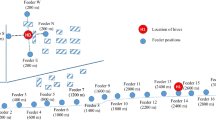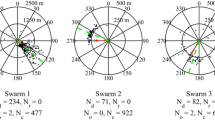Abstract
Honeybees have a dance language by which successful foragers inform nestmates about attractive food patches. The classical concept of dialects in the dance language of honeybees points to two differences in the dances by different species and races, firstly in the flight distance at which the dancers start performing waggle dances instead of round dances, and secondly in the circuit duration of the waggle dance performed for a given flight distance. However, recent findings have indicated that the dance language is influenced and affected by a number of parameters, both genetic and environmental. The current study was carried out to see whether the distance at which dancers change from round dances to waggle dances is statistically different in two different species, Apis mellifera carnica and A. florea and to develop a set of definitions for such comparative studies. Results show that the two species do not differ in the relative proportion of waggle dances and round dances performed at a given distance. Thus, this study points to the need of addressing the dialect question again.




Similar content being viewed by others
References
Boch R (1957) Rassenmässige Unterschiede bei den Tänzen der Honigbiene (Apis mellifica L.). Z Vergl Physiol 40:289–320
Esch HE, Zhang S, Srinivasan MV, Tautz J (2001) Honeybee dances communicate distances measured by optic flow. Nature 411:581–583
Frisch K von (1967) The dance language and orientation of bees. Belknap/Harvard University Press, Cambridge, Massachusetts
Jensen IL, Michelsen A, Lindauer M (1997) On the directional indications in the round dances of honeybees. Naturwissenschaften 84:452–454
Johnson RN, Oldroyd BP, Barron AB, Crozier RH (2002) Genetic control of the honey bee (Apis mellifera) dance language: segregating dance forms in a backcrossed colony. J Hered 93:170–173
Jones RH, Molitoris BA (1984) A statistical method for determining the breakpoint of two lines. Anal Biochem 141:287–290
Kirchner WH, Lindauer M, Michelsen A (1988) Honeybee dance communication: acoustical indication of direction in round dances. Naturwissenschaften 75:629–630
Lindauer M (1956) Über die Verständigung bei indischen Bienen. Z Vergl Physiol 38:521–557
Michelsen A, Andersen BB, Storm J, Kirchner WH, Lindauer M (1992) How honeybees perceive communication dances, studied by means of a mechanical model. Behav Ecol Sociobiol 30:143–150
Oldroyd BP, Rinderer TE, Buco SM (1991) Honey bees dance with their super-sisters. Anim Behav 42:121–129
Rinderer TE, Beaman LD (1995) Genic control of honey bee dance language dialect. Theor Appl Genet 91:727–732
Seeley TD, Mikheyev AS, Pagano GJ (2000) Dancing bees tune both duration and rate of waggle run production in relation to nectar-source profitability. J Comp Physiol A 186:813–819
Sokal RR, Rohlf JF (1994) Biometry. Freeman
Srinivasan MV, Zhang SW, Altwein M, Tautz J (2000) Honeybee navigation: nature and calibration of the “odometer”. Science 287:851–853
Tautz J, Rohrseitz K, Sandeman DC (1996) One-strided waggle dance in bees. Nature 382:32
Acknowledgements
We would like to thank H. Pechhacker, who made our study at Lunz Am See possible, Melanie Raab and K.A. Ponnana for their help in carrying out the experiments in Würzburg and Bangalore, Raghavendra Gadagkar for suggestions and comments and the Centre for Ecological Sciences and the DFG (SFB 554 and GK 200) for funding. The experiments comply with the Principles of animal care, publication no. 86-23, revised 1985 of the National Institutes of Health and with the current laws of the respective countries in which the experiments were performed.
Author information
Authors and Affiliations
Corresponding author
Rights and permissions
About this article
Cite this article
Sen Sarma, M., Esch, H. & Tautz, J. A comparison of the dance language in Apis mellifera carnica and Apis florea reveals striking similarities. J Comp Physiol A 190, 49–53 (2004). https://doi.org/10.1007/s00359-003-0470-7
Received:
Revised:
Accepted:
Published:
Issue Date:
DOI: https://doi.org/10.1007/s00359-003-0470-7




